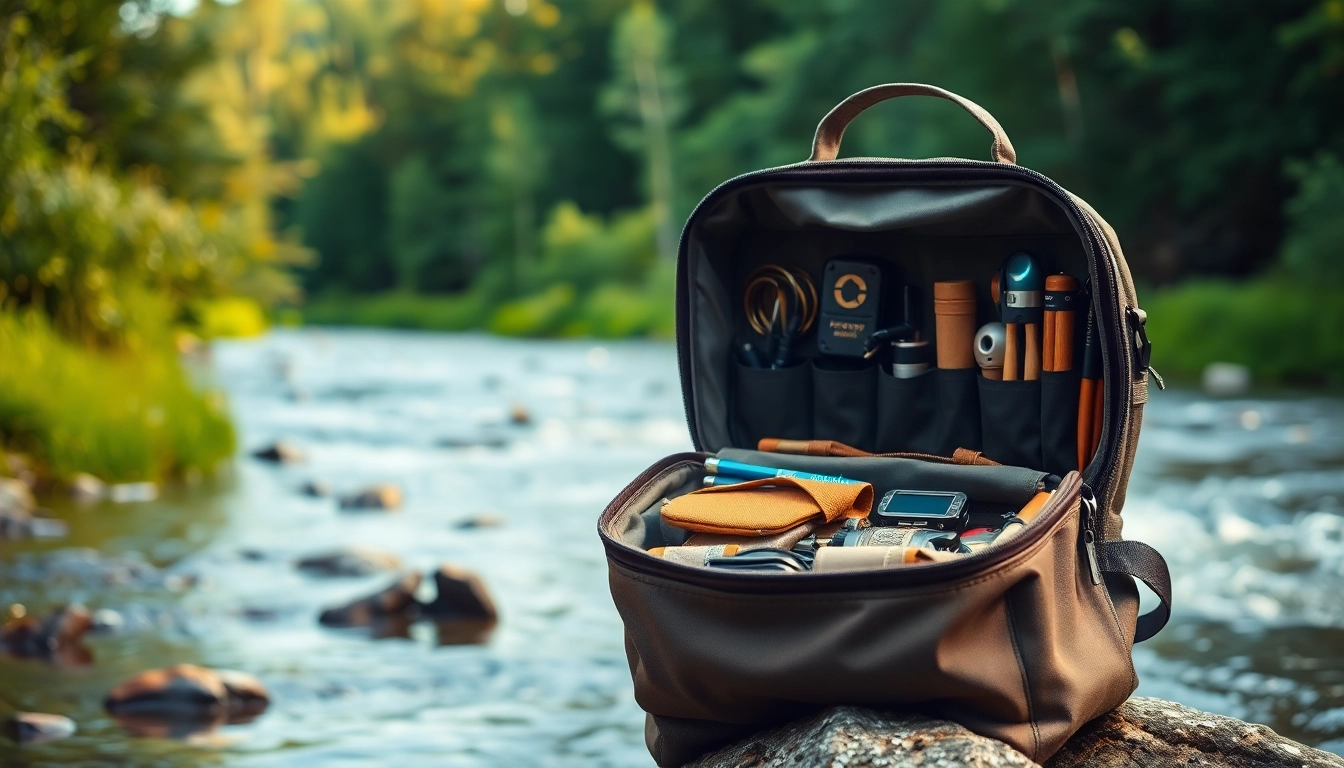Understanding the Importance of a Fly Fishing Bag
When it comes to enjoying a successful day out on the water, having the right gear is essential. Among the most crucial pieces of equipment for any fly fisher is the Fly fishing bag. This specially designed bag serves not only as a means to transport all your necessary gear but also helps organize your tackle, ensuring that everything you need is accessible when the moment arises. From your fishing flies to tools and snacks, the right bag can significantly enhance your fishing experience.
Functionality: What Makes a Good Fly Fishing Bag?
A good fly fishing bag is more than just a sack to carry your gear; it needs to integrate functionality into its design. The best bags are intended for specific uses within fly fishing. They often include features tailored to the unique demands of fly fishing, like designated compartments for flies, waterproof materials to keep gear dry, and attachment points for tools. The ideal bag also considers your fishing style, whether you’re wading through rivers, hiking to remote lakes, or enjoying a casual day at your local fishing hole.
Choosing the Right Size for Your Needs
Sizing is a critical factor when selecting a fly fishing bag. A bag that is too large can become cumbersome, while one that is too small may not accommodate all the essential gear. Assess your fishing habits: do you prefer to carry a few essentials or do you need a full set of tools, clothing, and snacks? Evaluating your typical day on the water can guide you toward the right size. It’s also worth considering the carrying methods, such as shoulder straps or belts, which can affect how the bag’s size feels when loaded.
Essential Features to Look for in a Fly Fishing Bag
When selecting a fly fishing bag, there are several features that can enhance its utility:
- Water-resistant material: The best bags are made of materials that can withstand splashes and rain, keeping your gear dry.
- Storage compartments: Look for bags with multiple compartments to store tools, leaders, and flies in an organized manner.
- Comfortable straps: Padded shoulder straps or those designed to distribute weight evenly can make carrying your bag much more comfortable.
- Accessibility: A bag that allows quick access to its contents is essential during a fishing trip when timing can be everything.
Types of Fly Fishing Bags Available
Comparing Chest Packs and Hip Packs
Chest packs and hip packs serve slightly different purposes, and understanding their differences can help you choose which is better suited for your needs. Chest packs offer easy access to flies and tools, positioning them right in front of you. They tend to be lighter and unobtrusive, perfect for short sessions or when your mobility is key.
On the other hand, hip packs are worn on the hips and offer greater capacity for carrying gear. They are excellent for those who need to carry more items but can be heavier and less accessible than a chest pack. The choice ultimately depends on your fishing style and the amount of gear you require.
Backpacks vs. Slings: Which Is Best?
Backpacks and sling packs both offer considerable benefits to the fly fisher. Backpacks are superb for long hikes to remote fishing locations, allowing you to carry extra gear and provisions effectively. They can be designed with hydration reservoirs, making it easy to stay hydrated during long days.
Sling packs, however, are designed to be worn across the body and can be easily swung around for quick access. They offer the best of both worlds when it comes to carrying gear comfortably while ensuring easy access to tools. Deciding between these two types depends largely on how much gear you need and how often you require access to it while fishing.
Waterproof Features in Fly Fishing Bags
Waterproofing is a non-negotiable feature for any fly fishing bag. A good bag will shield your flies, tools, and other essentials from unexpected rain or splashes from the water. Look for bags that are constructed with waterproof zippers and seam-sealed materials. Additionally, some models may use advanced waterproof fabrics which are particularly beneficial for anglers who find themselves in extreme conditions. Investing in a truly waterproof bag can save you money in the long run by preserving your gear.
Customizing Your Fly Fishing Bag Setup
Organizing Fishing Gear for Efficiency
Efficient organization within your fly fishing bag can greatly enhance your fishing experience. Start by categorizing your gear based on type or function. Keep flies in one compartment, tools in another, and personal items such as snacks or drinks in separate sections. Utilizing small storage boxes or pouches can help maintain this organization, making it easier to locate items quickly.
Additionally, consider your fishing environment—does it require specific tools? Adapt your organization to ensure you are fully prepared for different fishing scenarios. This attention to detail can lead to a smoother, more enjoyable day on the water.
Personalizing Your Bag for Style and Function
Your fly fishing bag does not have to be just functional; it can also express your personal style. Consider selecting a bag that reflects your individual aesthetics—this could be through design, color, or additional patches and accessories. There are plenty of ways to customize your bag while still maintaining its primary functionality. Just keep in mind that the modifications should not hinder its usability or performance.
Protective Inserts and Accessories
Protecting your tools and gear is key to enhancing the longevity of your fly fishing bag. Many bags come with protective inserts or can be fitted with specially designed padding that helps shield fragile items. Furthermore, consider adding exterior pouches or containers specifically designed for wet items or fragile equipment like reels. Protecting your gear ensures that it remains functional and extends the overall lifespan of your bag.
Maintenance Tips for Longevity of Your Fly Fishing Bag
Cleansing and Caring for Different Materials
Every fly fishing bag comes with its own unique materials, requiring different care techniques to maintain them. While some materials may handle dirt and debris better than others, regular cleaning is essential regardless of type. Use mild soap and water with a soft brush to clean your bag after each fishing trip, particularly if it has come into contact with saltwater or mud.
Additionally, check for specific instructions from the manufacturer on how to care for the materials used in your bag. Adhering closely to these guidelines will help prevent premature wear and maintain the bag’s waterproofing qualities.
Storing Your Fly Fishing Bag Properly
When your fishing season winds down, how you store your bag can significantly influence its longevity. Ensure the bag is clean and dry before putting it away to avoid any mildew or odor buildup. Consider a cool, dry, and dark area for storage; exposure to direct sunlight or harsh conditions can damage materials over time. Utilizing protective covers or storage bins can provide added benefits for keeping your bag in pristine condition.
Repairing Minor Damage to Extend Lifespan
Even the best fly fishing bags may face wear and tear over time. Learning how to make minor repairs can drastically extend your bag’s lifespan. For small tears or holes, iron-on patches can be effective, or you can sew smaller rips using high-quality, water-resistant thread. Regularly inspect your bag for any areas that may need attention; catching issues early can prevent more serious problems down the line.
Where to Purchase Quality Fly Fishing Bags
Local Shops vs. Online Retailers
When considering where to purchase your fly fishing bag, both local shops and online retailers have their advantages. Local shops provide the benefit of physically inspecting the bag and getting a feel for sizes and materials. Additionally, knowledgeable staff can provide valuable input and recommendations tailored to your specific needs. However, online retailers often offer a wider variety of selections, making it easier to compare products, read reviews, and potentially find better deals.
Finding Deals and Discounts
To maximize your budget, look for seasonal sales, clearance events, and promotional codes offered by retailers. Subscribing to newsletters from your preferred fishing stores can keep you informed about upcoming deals. Don’t hesitate to shop around, as prices may vary significantly between different retailers. However, while securing a good price is important, also consider the warranty and customer service options available, as these can be equally valuable in your purchasing decision.
Customer Reviews: What to Consider Before Buying
Before committing to a purchase, thoroughly examine customer reviews to gain insights into the experiences of others. Look for feedback on aspects such as durability, functionality, comfort, and overall satisfaction. Consider the common themes in reviews, as these will give you a clearer picture of how well a particular product meets its claims. Additionally, pay attention to any recurring issues that could affect your decision.




